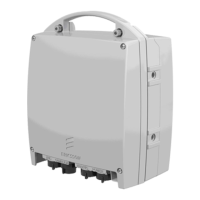MINI-LINK BAS 5-20
Technical Description EN/LZB 111 0542 P2B
5.5 MAC Layer
A fundamental feature for MINI-LINK BAS is an efficient MAC
protocol. An F-DCA is the key to handle burst traffic.
The medium access algorithm in the MINI-LINK BAS is optimised to
handle burst data traffic but efficiently handles also CBR and CE
Services.
The MAC protocol is accomplished by the MAC functions in the
Node and Terminal. The MAC function in the node acts as master
whereas MAC function in the terminal acts as slave.
The master MAC in the node polls each terminal about the status of
the queues that correspond to request for access the shared medium by
the NUs.
Depending on these terminals requests the master MAC will assign
permits to transmit in uplink direction to the different terminals. The
slave MAC functions in the terminals analyse the incoming permits
and take the correct action depending on type of permit.
The general idea is that no terminal is allowed to send data in uplink
direction, unless it has received an explicit permission to do so from
the master MAC in the node, see Figure 5-8.
upstream frame
FAS Gi atm cell G
atm cell
atm cell
atm cell atm cell
atm cell
atm cell
atm cell
atm cell
RI atm cell
atm cell
atm cell
atm cell
atm cell
G
G
G
G
G
G
G
G
Gi
FAS
MAC Frame
Radio Frame
atm cellatm cellatm cellatm cellatm cell
atm cell
RI
2*TOF
123456 78910
G = ATM traffic grant
Gi = ATs queues status grant
Ri = ATi queues status
TOFm = maximum Time Of Flight
FAS = Frame Alignament Signal
Radio Frame = time between two unscrambled FAS
downstream frame
Figure 5-8 Up-Stream and Down-Stream Frames
1. The master MAC in the node issues different types of permits for
different functions.
2. ATM permit: the specified NU is allowed to send one ATM cell,
CBR or UBR.
3. Polling permit: a group of 8 of NUs is allowed to send requests
toward the Node.

